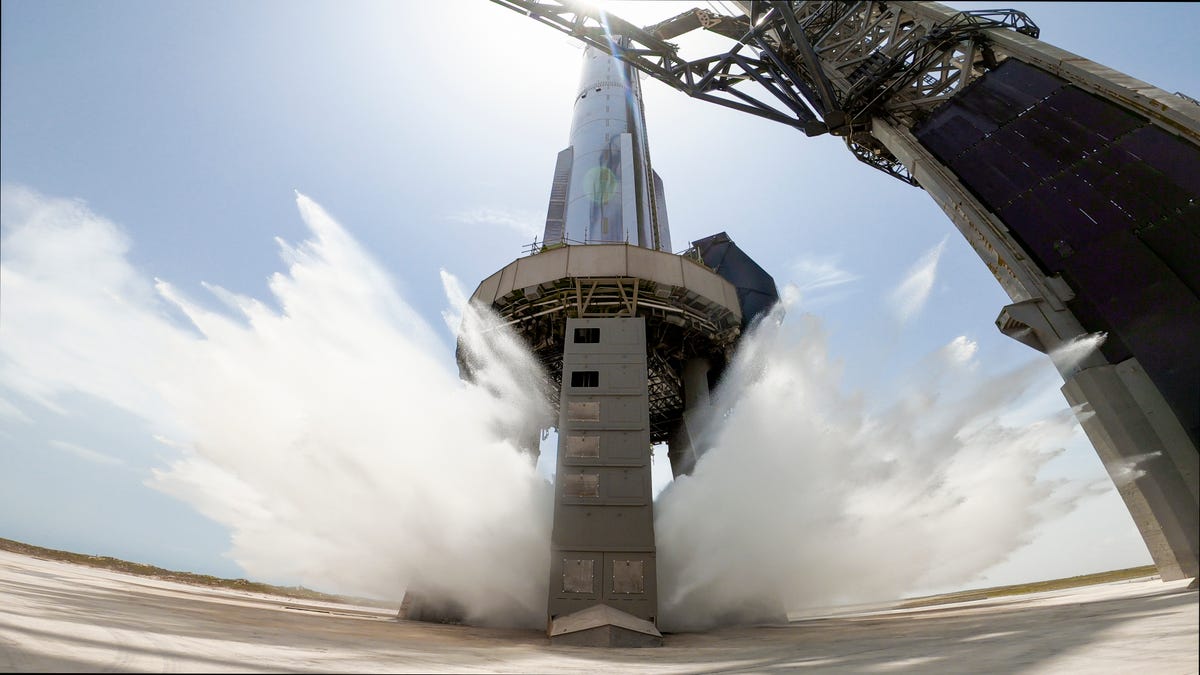
In the wake of an explosive debut in April, the U.S. Fish and Wildlife Service is conducting a review of SpaceX’s Starship launch system upgrades, focusing primarily on the new water deluge system and its potential environmental impacts at the south Texas launch site.
SpaceX’s Starship, an integral part of Elon Musk’s ambitious space plans, has been ready for its second test flight for over a month, as company officials told the U.S. Subcommittee on Space and Science earlier this month. Ground teams even performed a full wet dress rehearsal earlier this week, despite the absence of a scheduled launch date. The megarocket is currently grounded, awaiting the completion of the launch licensing process.
Advertisement
A newly initiated FWS review represents one of the final regulatory hurdles SpaceX must clear before it can proceed with its flight plans. This review formally began on October 19 in collaboration with the Federal Aviation Administration, according to an emailed FWS statement. The service needs to look at the potential environmental impacts and threats to endangered species in the sensitive Boca Chica region as a consequence of recent upgrades at SpaceX’s south Texas Starbase, particularly the newly installed water deluge system.
Advertisement
The problematic test flight on April 20, in which the rocket was abruptly triggered to self-destruct over the Gulf of Mexico, resulted in several serious issues at the launch site, including major damage to the launch mount, the igniting of several wildfires, disruption to local wildlife, the widespread scattering of debris across hundreds of acres, not to mention a dangerously botched self-destruct sequence. In response to this, SpaceX and the FAA conducted a joint investigation, leading to 63 proposed corrective actions for the private space company, which, by September 10, SpaceX claimed to have completed.
Advertisement
Among the upgrades is a new water deluge system, designed to mitigate the immense force and heat generated during liftoff by spraying water. It’s basically a gigantic bidet for rockets in terms of how it works, but a bidet that must quell the power of 33 angry Raptor engines producing a combined 16 million pounds of thrust. The FWS is now conducting its own assessment of the water system to ensure compliance with federal regulations. While it may seem a bit much to be so concerned about a system that sprays water into a rocket as it blasts off, SpaceX is required to adhere to stringent regulations related to the release of industrial process wastewater, as dictated by the federal Clean Water Act.
The FWS highlighted in its press release that the Endangered Species Act mandates restarting the formal consultation process if there are substantial modifications to a project and its effects, if new data emerges on species that were not previously taken into account, or if a species is newly added to the list. “For SpaceX reinitiation with FAA we are considering the operation of a deluge system at the launch pad,” the FWS wrote.
Advertisement
The FWS has until March 3, 2024, to complete an updated biological opinion on Starship’s environmental impact, though it does not anticipate it taking that long; the review process has the potential to conclude as soon as November 18 of this year. The FAA concluded its investigation in September, but as the FWS assessment is ongoing, the regulator has yet to grant SpaceX the necessary approvals for its proposed second flight. If the FAA determines that SpaceX’s modifications necessitate a reevaluation of its prior environmental assessment from 2022, a more extensive review may be required.
In August, the FAA attempted to restart consultations with the FWS by submitting a new biological assessment detailing the potential impacts of Starship modifications on local endangered species and habitats. But as Bloomberg reports, the FWS found the information inadequate for a formal review, prompting the FAA to provide an updated assessment on October 5. This led to the official commencement of the consultation process.
Related article: SpaceX Blames Understaffed FAA for Starship Regulatory Delays
Earlier this month, SpaceX officials blamed an understaffed FAA for Starship regulatory delays, saying the regulator should double the staff in charge of issuing space licenses. That very well may be the case, but SpaceX has only itself to blame for its recent regulatory woes. SpaceX, committing to the “move fast and break things” mantra is now mired in a regulatory quagmire largely of its own making.
Advertisement
Want to know more about Elon Musk’s space venture? Check out our full coverage of SpaceX’s Starship megarocket and the SpaceX Starlink internet satellite megaconstellation. And for more spaceflight in your life, follow us on X and bookmark Gizmodo’s dedicated Spaceflight page.
Services Marketplace – Listings, Bookings & Reviews